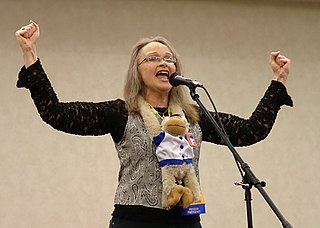
Dragonflight is a science fiction novel by the American-Irish author Anne McCaffrey. It is the first book in the Dragonriders of Pern series. First published by Ballantine Books in July 1968, it was a fix-up of two novellas which between them had made McCaffrey the first woman writer to win a Hugo and a Nebula Award.

Anne Inez McCaffrey was an American writer known for the Dragonriders of Pern science fiction series. She was the first woman to win a Hugo Award for fiction and the first to win a Nebula Award. Her 1978 novel The White Dragon became one of the first science-fiction books to appear on the New York Times Best Seller list.

The Rowan (1990) is a science fiction novel by American writer Anne McCaffrey, the first book in The Tower and the Hive series. It is set in the universe of the "Pegasus" trilogy, against a backdrop of a technologically advanced society in which telepathy, psychokinesis and other psychic talents have become scientifically accepted and researched. Telekinetic and telepathic powers are used to communicate and teleport spaceships through space, thus avoiding the light barrier and allowing for the colonization of other planetary systems.

Elizabeth Moon is an American science fiction and fantasy writer. Her other writing includes newspaper columns and opinion pieces. Her novel The Speed of Dark won the 2003 Nebula Award. Prior to her writing career, she served in the United States Marine Corps.

Dallas McCord "Mack" Reynolds was an American science fiction writer. His pen names included Dallas Ross, Mark Mallory, Clark Collins, Dallas Rose, Guy McCord, Maxine Reynolds, Bob Belmont, and Todd Harding. His work focused on socioeconomic speculation, usually expressed in thought-provoking explorations of utopian societies from a radical, sometime satiric perspective. He was a popular author from the 1950s to the 1970s, especially with readers of science fiction and fantasy magazines.

James Henry Schmitz was an American science fiction writer born in Hamburg, Germany of American parents.

Telzey Amberdon is a fictional character in a series of science fiction short stories and two short novels by American writer James H. Schmitz, taking place in his "Federation of the Hub" fictional universe, presumably in the mid-4th millennium. She is introduced as a fifteen-year-old genius, a first-year law student, living on the human-settled planet Orado. Through interaction with alien psychic animals on a resort planet, she discovers that she has psychic powers. Upon her return to her home planet, her abilities are recognized by a mechanism at the spaceport reentry gate and she is effectively made an agent of the Psychology Service. A major pattern in the stories is the development of her powers. Eventually she teams up with the redheaded secret agent Trigger Argee. The series ends inconclusively; in the last story, a villain makes a duplicate of her, who gains a separate identity and name.

The Ship Who Sang (1969) is a science fiction novel by American writer Anne McCaffrey, a fix-up of five stories published 1961 to 1969. It is also the title of the 1961 novelette which is the first of these stories. The series started by the book, the "Brain & Brawn Ship series", is sometimes called the "Ship Who Sang series".

Maya Kaathryn Bohnhoff is an American sci-fi and fantasy author and filk musician. As an author, she collaborated on several novels in the Batman and Star Wars franchise with Michael Reaves, and as a filk musician, she is a three-time Pegasus Award winner.

Pegasus in Flight (1990) is a science fiction novel by American writer Anne McCaffrey set in her "Talents Universe". It is the sequel to a 1973 collection of short stories, To Ride Pegasus, and its 2000 sequel Pegasus in Space completed a trilogy.

Pegasus in Space (2000) is a science fiction novel by American writer Anne McCaffrey, set in her "Talents Universe" series. It is the sequel to Pegasus in Flight and it completed a trilogy initiated in 1969.

Damia is a 1992 science fiction novel by American writer Anne McCaffrey; it is the sequel to The Rowan, and the second book of The Tower and the Hive series.

Damia's Children is a 1993 science fiction novel by American writer Anne McCaffrey, forming part of the Talent series. Damia's Children forms a two-part story with the novel Lyon's Pride.

Lyon's Pride is a 1994 novel by Anne McCaffrey, which continues the storyline begun in Damia's Children. It was published by Ace in the US/Canada, and Bantam in the UK.

The Tower and the Hive is a 1999 science fiction novel by American writer Anne McCaffrey, the concluding volume of a five-book series also referred to as The Tower and Hive series.
The Mrdini are a fictional extraterrestrial species from the Rowan/Talent series by Anne McCaffrey. They first appear in the novel Damia.

Get Off the Unicorn is a collection of science fiction short stories by American writer Anne McCaffrey, first published in paperback by Del Rey Books in June 1977. Eleven of the fourteen stories were previously published in various magazines and anthologies. Initial sales were brisk; two additional printings were required by year's end. Del Rey reprinted Get off the Unicorn regularly throughout the 1970s and 1980s, and its edition remains in print as of 2015. Corgi issued a British edition in 1979 and an Australian edition in 1980. An audiobook based on the Corgi edition was released in 1985. Severn House issued a hardcover edition in 1982.
Sasha Miller is the pseudonym of American fantasy writer Georgia Myrle Miller. She has also written under the names Georgia Sallaska, Myrle Benedict, and G. S. Madden.
This is a list of works by American science fiction and fantasy author Anne McCaffrey, including some cowritten with others or written by close collaborators.
















